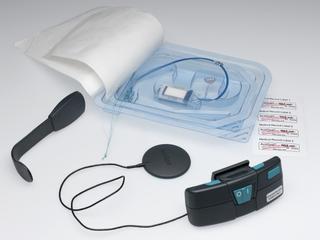
Brass scarificator with 16 lancets in leather case
- Made:
- 1701-1900

Brass scarificator with 16 lancets in leather case, for bloodletting, inscribed with the name 'Erhardt', 18th or 19th century
Scarificators were medical instruments designed to quickly and efficiently produce multiple small, regular cuts on the skin of a patient. Such devices were first developed in the early 1700s and reached their highest levels of use and sophistication during the 19th century. They were once essential tools for the practice of bloodletting, which was of the commonest treatments employed by generations of doctors to tackle a range of diseases and other medical conditions.
Such practices were based on ancient systems of medicine where blood, along with other bodily fluids, were seen as ‘humours’ that had to be kept in balance to maintain good health. As new understanding about health and the body replaced these old ideas, so the practice of bloodletting was gradually abandoned.
Usually square, round or even octagonal in shape, scarificators contain a spring loaded mechanism which would be primed – usually via a small lever – and then placed blade-side down, usually against the patient’s arm. It would then be triggered via a button-like structure and the blades would emerge and sweep across the skin at high speed, leaving a series of shallow cuts. Typically these devices had at least four blades, many had six, eight, ten or twelve, though some designs had even more. This example has sixteen. Scarification was often associated with the practice of cupping, whereby a warmed glass vessel would be placed over the area of bleeding, creating a vacuum as it cooled which would then draw the blood out.
The scarificator was once in the private collection of Dr Noel Hamonic, a prolific French collector who died in 1928 – many of his artefacts were then purchased by Henry Wellcome in that same year.
Details
- Category:
- Therapeutics
- Collection:
- Sir Henry Wellcome's Museum Collection
- Object Number:
- A121601
- Materials:
- scarificator, steel, scarificator, brass and case, leather
- type:
- scarificators
- credit:
- Hamonic Collection




